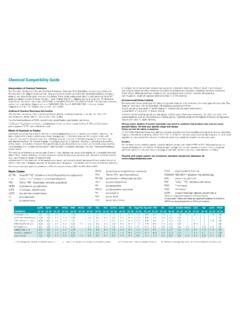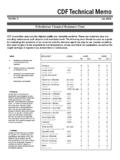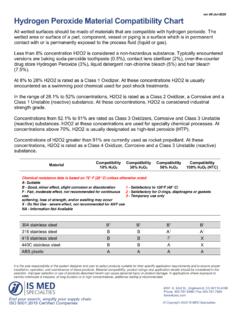Transcription of The chemical resistance of plastics
1 LDPEHDPEPPPMP (TPX)PVCPCPSSANPMMAPTFEPOMPBTT emperature C205020502050205020502050205020502050205 020502050 Acetaldehyde3132212111211111113333 Acetic Acid (Glacial)21333222311111111133111 Acetic Anhydride1122223211111111112211 Acetone21112133111111111133332 Ammonium Chloride (10%)33333333322233332233 Ammonium Hydroxide (30%)3333333331122222223333 Amyl Acetate21322132111111113333333 Aniline (Phenylamine)32333332111111111133222 Aqua Regia11111111111111211133331 Benzaldehyde3221123211111111113333 Benzene11111111111111111133323 Benzoic Acid333332333232223333331 Boric Acid (10%)33333333333333333333333 Butyl Acetate22222222311111111133322 Butyric Acid (Butanoic acid)112111113111111111333 Calcium Hydroxide (Saturated)33333333331122332133333 Carbon Disulphide1111111111111111113333 Carbon Tetrachloride2121211131111121113322 Chloroform21211111111111111133111 Citric Acid (1M)3333333333333333333 Cresol112122111111211111331 Cyclohexane212121111132112123333 Dibutyl Phthalate21212122112111111133333 Dichlorobenzene2121211111111111113311 Diethyl Ether11212111311111111133333 Diethylene Glycol33333333212233331133331 Dimethyl Formamide (DMF)33333333111111111133333 Dimethyl Sulfoxide (DMSO)33333333111121111333 Dioxane222211221111111111332221 Ethyl Acetate (Ethyl Ester)333321211111111111221 Ethyl Alcohol (Absolute Ethanol)32333332333232111133333 Ethyl Chloride (Chloroethane)21112121111111111133 Ethylene Chloride2111212121111111113311 Ethylene Oxide (Pure)22222121112111113333332 Ethylene Oxide (Gas)22333322223332223333 Formaldehyde (Formalin)
2 40%32323333333322213233333 Formic Acid (50%)2233323331222232332 Formic Acid (100%)22333233312122113311 Glycerine (Glycerol)33333333333333333333223 LDPEHDPEPPPMP (TPX)PVCPCPSSANPMMAPTFEPOMPBTT emperature C205020502050205020502050205020502050205 020502050 Hexane1122222131211133333333 Hydrobromic Acid (69%)33323233332222221133111 Hydrochloric Acid (5%)3333333333333333233111 Hydrochloric Acid (35%)33333232332133321133111 Hydrofluoric Acid (48%)33333232222111321133112 Hydrogen Peroxide (30%)33333232333332332133313 Lactic Acid (85%)33333232323233333333313 Methyl Acetate3133322111111111331 Methyl Alcohol (Methanol)32333332332222111133333 Methyl Ethyl Ketone (Butanone)111133311111111111333 Methylene Chloride (Dichloro Methane)11313131111111111133111 Mineral Oil23333232333333333333333 Nitric Acid (10%)3322222223322322333112 Nitric Acid (70%)31311131111111111133112 Nitrobenzene11111131111111111133213 Oxalic Acid (10%)33333333333333333333333 Perchloric Acid (70%)2121212121112222332211 Phenol (100%)11111111111111111133111 Phosphoric Acid (85%)3133323232323233213331 Picric Acid111111331111223333 Potassium Hydroxide (30%)33333333331122333333331 Potassium Permanganate33333233323332222133223 Propylene Glycol33333333222233333333 Pyridine1111332111111111113332 Salicylic Acid333333332232323233113 Silver Nitrate32333333323333323322 Sodium Hydroxide (50%)22333333331132323133331 Sodium Hypochlorite (15%)323221333322323333331 Sulphuric Acid (20%)33333333323233323333 Sulphuric Acid (60%)3232223232223211113311 Sulphuric Acid (98%)22222322211122111133111 Tetrahydrofuran (THF)
3 21232222111111111133223 Toluene21111122111111111133113 Trichloroacetic Acid2121223321212111331 Trichloroethylene11111111111111111133111 1 Turpentine21212121222111212133333 Xylene11211121111111111133331 Zinc Chloride (10%)33333333333333333333323 Zinc Sulphate (10%)33333333333333333333212 Good resistance :continuous exposure to the substance causes minor damage within 7 - 30 resistance :not suitable for continuous exposure to the substance. Immediate damage may resistance :continuous exposure to the substance does not cause damage within 30 physical properties of plastics *Permeability (cc- ). Polymer may be malleable at temperatures above 80 C if the product is under structural stress. Material may become brittle at low usage Temp. CMin usage Temp. CTransparencyFlexabilitySpecific GravityMicrowaveableAutoclavableGasDry HeatRadiation (Gamma)DisinfectionN2O2CO2 Water Absorbtion (%)CytotoxicLDPEHDPEPPPMP (TPX)
4 PCPSPMMAPTFEPFA80120 1351451359050260260-50-100-20 0 sNoYe sYe sMarginalNoNoYe sYe sNoNoYe sYe sYe sNoNoYe sYe sYe sYe sTesYe sYe sYe sNoYe sYe sNoNoNoYe sNoNoNoYe sYe sYe sYe sNoNoYe sYe sYe sYe sNoYe sYe sYe sYe sYe sSomeSomeYe sYe s18042488,00050253 Unknown29150018524032,000300400123088812 ,700580800115,0001,0751,50068 Unknown2,260< < < < < *Polytetrafluoroethylene, PTFEl Opaque rigid polymerl Wide temperature range 200 to +260 Cl Autoclavable at 121 C l Unrivalled resistance to almost all chemicals l Extremely low friction coefficientl Typically used for bottles, beakers and stirrers Polyfluoroalkoxy, PFA l Translucent flexible form of PTFEl Wide temperature range -260 to +260 Cl Autoclavable at 121 C l Excellent chemical resistancel Typically used for trace metal analysis bottles Polymethylmethacrylate, Acrylic (PMMA)
5 L Transparent rigid polymerl Narrow temperature range -60 to +50 Cl Not autoclavable at 121 C l Moderate chemical resistancel Very tough and high clarityl Typically used for radiation shields Polystyrene, PSl Transparent rigid polymerl Narrow temperature range -40 to +90 Cl Not autoclavable at 121 C l Moderate chemical resistancel Brittle yet has excellent clarityl Typically used for container ware Polyvinylchloride, PVCl Rigid polymerl Narrow temperature range -25 to +70 Cl Not autoclavable at 121 C l Moderate chemical resistancel Rigid or flexible, coloured or clear l Typically used for trays and troughs Polypropylene, PP l Translucent rigid polymerl Temperature range -20 to +135 Cl Autoclavable at 121 Cl Good to excellent chemical resistance l Resistant to fatigue making it toughl Typically used for beakers, bottles and cylinders Low Density Polyethylene, LDPEl Translucent flexible polymer l Narrow temperature range of -50 to +80 Cl Not autoclavable at 121 Cl Good to excellent chemical resistancel Robust and virtually unbreakable l Typically used for wash bottles High Density Polyethylene, HDPEl Translucent rigid polymer l Broad temperature range of -100 to +120 Cl Not autoclavable at 121 Cl Good to excellent chemical resistancel High tensile strength making it very tough l Typically used for bottles Polymethylpentene, PMP (TPX)
6 L Transparent rigid polymerl Broad temperature range -180 to +145 C l Autoclavable at 121 Cl Good to excellent chemical resistance l Has a low density and a high clarityl Typically used for beakers and cylinders Polycarbonate, PCl Transparent rigid polymerl Broad temperature range -135 to +135 C l Autoclavable at 121 C l Moderate chemical resistancel High impact strength l Typically used for safety shields SciLabware Limited, Unit 4, Riverside 2, Campbell Road, Stoke-on-Trent, Staffordshire, ST4 4RJ, wUK +44 (0) 1782 444406 This technical information is provided in good faith by SciLabware Limited for the safety of its customers. Please note that the advice given is for general laboratory applications and may not necessarily apply to all tests or procedures. The A-Z of reusable plastic labwareSciLabware Limited, Unit 4, Riverside 2, Campbell Road, Stoke-on-Trent, Staffordshire, ST4 4RJ, wUK +44 (0) 1782 444406 This technical information is provided in good faith by SciLabware Limited for the safety of its customers.
7 Please note that the advice given is for general laboratory applications and may not necessarily apply to all tests or procedures. The A-Z of reusable plastic labwareSciLabware Limited, Unit 4, Riverside 2, Campbell Road, Stoke-on-Trent, Staffordshire, ST4 4RJ, wUK +44 (0) 1782 444406 This technical information is provided in good faith by SciLabware Limited for the safety of its customers. Please note that the advice given is for general laboratory applications and may not necessarily apply to all tests or procedures. A-Z of reusable plastic labwareThe chemical resistance of plasticsThis chart gives general guidelines on the chemical resistance of plastics . There are many factors that influence chemical resistance , we therefore recommend that you test for your own application before selecting the appropriate product. If you have any doubts please contact us for information available.



